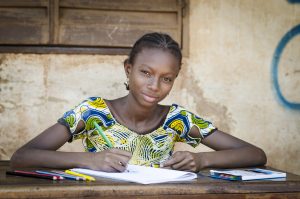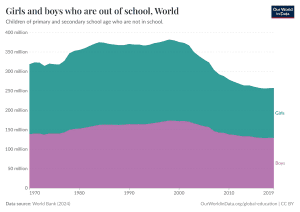The improvement in girls’ education worldwide is one of our greatest global success stories. In the past 50 years, girls’ educational access has increased so that nearly all girls around the world receive primary education, and the rate of secondary enrollment for girls has more than doubled. In 2024, more girls were enrolled in school than boys worldwide, and among secondary students, girls had higher rates of proficiency in both reading and math.

Despite this overall global success, 122 million girls worldwide were out of school in 2025. Though many areas with high out-of-school rates for girls have similar numbers for boys, persistent inequities remain in some areas, especially in countries facing conflict.
How Conflict Drives Inequality in Girls’ Education
Though overall global data about girls’ education shows enormous progress made in recent years, girls still face huge barriers to accessing education in the most vulnerable parts of the world. In countries facing ongoing conflict and other societal fragilities, like Myanmar and South Sudan, girls are 2.5 times as likely to be out of school than they would be in other contexts and are 90 percent less likely to be enrolled in primary school.
Sometimes this educational disruption is intentional, like Afghanistan’s ban on secondary education for girls. But girls are more likely to have their education disrupted during conflict due to the threat of violence, especially sexual violence, and face barriers to school attendance when they are required to take on greater family responsibilities like childcare. Of the countries with the lowest rates of primary school enrollment for girls, more than half are considered fragile or conflict-affected.
What Are the Key Barriers to Girls’ Education?
Many of the factors that keep girls out of school are the same things that impede boys’ education as well. When schools lack adequate infrastructure and educators, or require long traveling distances to access, children are less likely to attend school. But other barriers to girls’ education are strongly tied to their gender.
Girls who lack access to menstrual hygiene products are often unable to attend school. Even when girls do have access to menstrual products, they may lack adequate sanitation facilities at school where they can safely manage their periods. In some areas, girls who are menstruating are banned from attending school entirely, even when the practice has ostensibly been outlawed.
Family responsibilities can also act as barriers to girls accessing education. Girls are more likely to serve as caretakers for family members and are more likely to perform chores related to food and water access. When families are struggling to access needed resources, girls are often pulled out of education before boys are.

In areas where girls are commonly married before the age of 18, girls typically end their formal schooling once they are married. When girls lose out on their education and are married as children, they face long-term negative effects to their health, employment opportunities, and independence. Keeping girls in school is one of the most critical ways to reduce child marriage rates.
Global Initiatives and the Future of Girls’ Education
The United Nations Girls’ Education Initiative (UNGEI) is a UNICEF program that aims to alleviate gender inequalities in education worldwide through partnering with educators and activists to support policies around the world that improve girls’ educational access. Country-specific initiatives also exist all around the world, like India’s Beti Bachao, Beti Padhao program that seeks to empower girls in their education and throughout their entire lives.
Investing in girls’ education has major impacts for a country’s economic and social development. Girls who go to school have higher living standards, better access to skilled employment, and more control over their lives and futures. Ensuring global access to education for girls is a critical building block for a more equitable planet for all people.
Image credits: Girl in school (ID 527818981 © borgogniels | iStockphoto.com); Graph (Girls and boys who are out of school, World by Our World in Data is licensed under CC BY)


